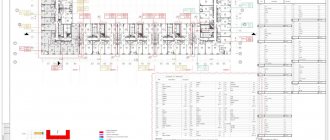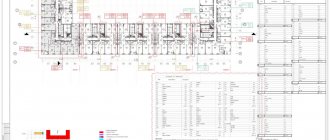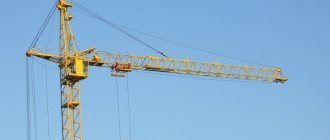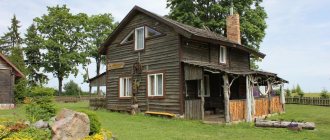Pravozhil.com > Mortgage > Benefits > Dilapidated house - what is it, the owner’s problem or an opportunity to get an apartment in a new building?
According to statistics, 15.6 million sq. m of the Russian housing stock are dilapidated and dilapidated houses. Most of such housing (up to 10 million) is concentrated in apartment buildings.
A problematic apartment or house forces the owner to look for a way out of the situation. And it exists: the country has a program for relocating citizens from unsuitable housing. But how is housing recognized as dilapidated, since this is a mandatory condition for participation in the program? Let's look at all the features below.
What is a dilapidated house? The concept of a dilapidated house or emergency housing
What is emergency housing? What is the difference between dilapidated housing and emergency housing?
No matter how the house crumbles, when contacting officials you need to appeal not with emotions, but with references to specific regulations.
If a private house or apartment in a high-rise creates maintenance problems and requires endless repairs, you should carefully study the following regulatory documents:
- Housing Code, which allows the premises to be declared unfit for living (Article 32, Article 86).
- Federal Law No. 185 “On the fund for promoting the reform of housing and communal services.”
- Resolution No. 47 of January 28, 2006, containing the principles and regulations for the inspection of residential buildings, as well as the recognition of housing as unsafe or dilapidated.
Both statuses are not everyday expressions, but define the official state of the building.
Dilapidated housing is not yet a reason to get a new living space
The fact is that there is no threat of collapse of such a building. The condition requires deep reconstruction and large-scale repairs. But the administration is not obliged to resettle people in this situation.
A house is considered a dilapidated structure depending on the degree of structural deterioration.
Important. Dilapidated load-bearing structures are able to perform their functions to a limited extent only if security work is carried out or after their complete replacement or reconstruction.
Calculation of wear and tear and the actual condition of the building is carried out according to departmental construction standards: VSN 53-86 (Gosstroy order No. 446 of 1986). The document contains:
- tables with specific loss of functionality indicators for each building element;
- formulas for calculus;
- quantitative and qualitative indicators of structural wear;
- recommended recovery measures.
This is a complex matter that requires qualifications. Therefore, specialists/companies that are members of SROs have the right to conduct examinations of structures. We are interested in the general conditions for recognizing a house as dilapidated:
- Dilapidation/wear of main structures is more than 70% for stone, brick buildings, fully prefabricated panels.
- From 65% - for wooden buildings, attic structures.
What Percentage Of House Wear Is Considered Unsafe?
The dilapidated condition of a building is a condition in which the structures, foundation (building as a whole), as a result of high physical wear and tear, no longer meet the specified operational requirements (“Methodological recommendations for protecting the rights of participants in the reconstruction of residential buildings of various forms of ownership” (approved by Order of the State Construction Committee of the Russian Federation dated November 10. 1998N
4. Dilapidated residential building - a residential building with physical wear and tear, in which its strength and deformation characteristics are equal to or lower than the maximum permissible characteristics established by regulatory documents for current loads and operating conditions.
Emergency housing (read more…)
Criteria for classifying housing as emergency
There are several reasons. They relate to geographical, sanitary, hygienic and technological operating conditions. Let's turn to section III of the post. 47. According to the standards, the condition of the house and the living conditions in it are considered unsatisfactory in the following cases:
- location of real estate in areas prone to natural disasters (mudflows and snow slides, frequent floods with significant flooding, collapses of slopes and rocks, etc.);
- construction of a house in dangerous proximity to fire and explosive objects, in industrial areas;
- non-compliance with standards for noise and vibration levels, magnetic and ionizing radiation, emissions of harmful chemicals into the atmosphere. connections. For example, a house in the immediate vicinity of a power line or with windows facing a highway;
- microclimate of the premises and adjacent territory that does not meet SanPiNs;
- damage to structures and equipment from explosions, earthquakes, man-made accidents, ground movements;
- destruction of the building over time.
Housing with obsolete structures or deficiencies caused by engineering/architectural features is not considered unsafe:
- one- and two-story residential buildings without hot water supply and sewerage systems;
- lack of garbage chutes and elevators in buildings above 5 floors. At the same time, the structure was recognized as being of limited serviceability and not subject to restoration or major repairs.
The procedure for recognizing an accident
The procedure for recognizing an apartment building as unsafe is determined by the relevant Regulations approved by Decree of the Government of the Russian Federation No. 47. According to this document, several stages should be distinguished in recognizing housing as unsuitable for citizens to live in. Let's look at each of them in detail.
Establishing the fact of unsuitability for residence
The fact of an accident itself must be established by an appropriate examination. It should be noted that this requires the initiative of one of the interested parties.
Thus, the initiators of recognition can be:
- a municipality that manages housing stock that is in unsatisfactory condition;
- Rospotrebnadzor authorities within the framework of requests received to them
- fire inspection;
- residents of the house.
In practice, most often the initiators are the residents of the house. To start the process, they need to collectively submit an appeal to the municipal administration. Based on the results of consideration of this appeal, a decision is made to form an interdepartmental commission that will conduct an examination of the technical condition of the apartment building. Based on the results of the commission’s work, a conclusion is made on recognizing the house as unsafe or on the impossibility of assigning this status to it.
If the condition of the house is considered inadequate, then the residents are resettled within a few months , and the building itself becomes subject to demolition.
Separately, mention should be made of the possibilities for relocating architectural monuments. If a building has a protected status, then it cannot be demolished as such. In this regard, its reconstruction is being carried out. The latter is carried out both with the involvement of budget funds (if the house is included in the corresponding regional or federal program) and with the involvement of funds from the owners of the building.
Collection of documents
When submitting an application to the municipality, residents must provide the following package of documents:
- Statement. The document is signed by all interested owners of residential premises.
- Copies of citizens' passports.
- Title documents for residential premises. Certificates of ownership and extracts from the Unified State Register serve as title documents.
- Expert opinion. If an examination of the condition of the load-bearing structures of the apartment building was previously carried out, then its conclusion must be attached to the application.
Reference! This list is not exhaustive. In practice, the interdepartmental commission may request other documents to conduct a full assessment.
Inclusion in the house demolition register
Information about apartment buildings that are subject to demolition is entered into the appropriate schedules. Thus, passports of regional resettlement programs and schedules are entered into the federal register. The information contained in it can be found on the Housing and Communal Services Reform portal.
In addition, demolition schedules are publicly available on the websites of regional authorities.
How to officially recognize housing as unsatisfactory?
By what criteria can housing be classified as unsafe?
An examination of the building and its premises by an interdepartmental commission will be required (Article 15 of the Housing Code of the Russian Federation). This is not a one-day procedure, since several actions are carried out:
- Instrumental control.
- Laboratory research.
- Design, survey and specialized examinations.
- Data analysis with commission verdict.
The result of the work of state representatives is an act of the established form. The document reflects:
- the current state of the object, its engineering and structural elements;
- characteristics of the adjacent territory;
- details of deviations from standards identified during the research: instrument readings, instrumental measurements;
- assessment of expert results: whether safe operation of the building or its reconstruction/repair is possible, whether relocation of residents is required.
The results of the examinations are prepared in writing by specialists and attached to the report.
From a complaint to receiving the keys to a new apartment: actions of the owners
The persistence of applicants for resettlement must go “hand in hand” with a clear algorithm of actions. To do this, let us turn to Section IV of the government decree:
- the owner sends an application and a package of documentation to the administration of the “register” of the building;
- responsible persons are determined with additional papers and stages of home inspection;
- the municipality creates an interdepartmental commission and attracts experts to the work;
- a set of measures is being carried out to assess the building, design and survey work. If the building is multi-apartment, each apartment is inspected. After completing the practical part, a report is drawn up.
The results of the inspection with proposals for relocation or reconstruction of the house are communicated to the applicant, local authorities, and interested supervisory authorities. All information must be sent to the recipients by official written communication.
Important. The homeowner has the right to participate in the inspection of the house in an advisory capacity.
What documents must the owner prepare?
Who recognizes the house as unsafe?
An application supported by a package of documents is sent to the housing commission of the municipality:
- Notarized copies of the grounds for ownership/ownership.
- Technical passport of the apartment, cadastral plan of the premises.
- Previously submitted applications with responses from officials, results of surveys.
- Certificates and extracts that facilitate an objective consideration of the issue on its merits.
After receiving the application, officials are required to create an interdepartmental commission within a month.
Dilapidated housing is housing that is unfit for habitation. Arbitrage practice
Criteria for classifying housing as dilapidated Dilapidated condition of a building is a condition in which the building structures and the building as a whole are worn out: for stone houses - over 70%, wooden houses with walls made of local materials, as well as attics - over 65%, the main load-bearing structures are preserved strength sufficient to ensure the stability of the building, but the building no longer meets the specified operational requirements.
- After how many years is a house considered unsafe?
- What year are houses considered unsafe?
Many criteria and internal regulations do not give a clear idea of which houses are unsafe and which are not? The percentage of wear must be at least 70% . The figure is calculated using construction formulas and a calculator. However, in practice, this scheme does not always work.
How to challenge the commission's decision?
Let's face it: residents face a difficult task. You will have to run around the bureaucratic offices and personally study the regulatory framework of the issue.
Sometimes they initiate legal proceedings, since by hook or by crook the administration seeks to save its budget.
Important. Disputes arising with resettlement are resolved by the district court.
Judicial practice shows that the parties mainly dispute:
- inaction of the municipality after the applicants’ appeal;
- decisions of interdepartmental commissions regarding recognition of real estate as emergency, proposed measures;
- extended resettlement periods;
- unequal replacement or underestimation of the actual cost of housing when issuing compensation.
Resettlement program
What does the emergency housing resettlement program offer?
Replacement of outdated housing stock is carried out comprehensively. For these purposes, the state program “Housing” has been in effect since 2002:
- funds are included in the federal budget and sent to the regions;
- Local conditions have been developed under which citizens can count on improved living conditions.
The state program was extended in 2010 and 2014, and on September 31, 2021, activities at the federal level will be completed.
The constituent entities have prepared their own measures to resettle citizens from emergency premises. It is clear that conditions vary depending on the capabilities of the territory. But we can highlight some general provisions:
- In exchange for the lost apartment, a person receives a room of equal size and number of rooms.
- even from poorly equipped dwellings, resettlement occurs only in modern apartments that meet the requirements of energy efficiency, comfort and safety;
- if the displaced person used the living space under a social tenancy agreement, a new apartment is provided on the same terms;
- the allocated housing must be located within the same administrative district as the old house;
- after a verdict on demolition of the building is made, resettlement must occur within 1 year. All moving costs are borne by the municipality. But no one will allow the owner to abuse this right either: transport for transporting property is allocated once.
If living in a house is not possible, you need to find out about the specific conditions for resettlement from the municipal administration.
You can count on compensation for the estimated cost of housing, the provision of equivalent premises, and the execution of a social tenancy agreement. The option is selected depending on the characteristics of the old housing, the preferences of the owner and the conditions of the regional program.
You can learn how to recognize a house as dilapidated (emergency) by watching the video:
See also Phone numbers for consultation Jan 16, 2021 kasjanenko 1004
Share this post
Discussion: 6 comments
- Lera says:
02/04/2018 at 00:40It’s better to have a private house, then all the problems of home repairs will be on your shoulders, and this is still better than going and trying for years to move from a dilapidated house to a normal home.
Answer
- Lara says:
02/05/2018 at 01:11
It’s really very difficult to get a new apartment in a dilapidated house, that’s why our houses where people live are falling apart, this is not because they are very stupid and cannot defend their rights, but because they are not allocated housing.
Answer
- Liza says:
02/22/2018 at 00:31
Audio and video recording is, of course, good, but it’s not always effective; in order to achieve something, you probably just need to get bored, so that you are allocated housing so that you just fall behind.
Answer
- 5master5 says:
04/13/2019 at 06:41
Lera, it’s not at all better to have a private house. It constantly requires investments for repairs and maintenance from the family budget. You will never receive help from the state. And for the rest of your life you will be forced to invest money in it, unlike those living in an apartment building.
Answer
- Nikolay says:
06/23/2019 at 09:37
A dilapidated house can definitely be considered unsafe and unsuitable for habitation. But people living in a private house do not face such happiness. At best, they may be offered to sell it and buy a room in a small family.
Answer
- Olga says:
02.11.2019 at 16:42
I came across this problem. My grandparents lived in a dilapidated house and took them in because no one provided them with anything. Therefore, I consider this problem only the problem of the owner. Probably, it is necessary to sell such housing in advance, before it reaches 100 years.
Answer
Dilapidated and emergency housing. What is the difference and why is one subject to resettlement and the other not? In fact, the concept of emergency housing is described in the DECISION OF THE GOVERNMENT OF THE RUSSIAN FEDERATION dated January 28, 2006 No. 47 “On approval of the Regulations on recognizing premises as residential premises, residential premises unsuitable for habitation and an apartment building as unsafe and subject to demolition or reconstruction,” which states: “ 4 A residential premises is an isolated premises that is intended for the residence of citizens, is immovable property and is suitable for habitation.
5. Residential premises are recognized as: residential building - an individually defined building, which consists of rooms, as well as premises for auxiliary use, intended to satisfy citizens' household and other needs related to their residence in it; apartment - a structurally separate room in an apartment building, providing direct access to the common areas in such a house and consisting of one or more rooms, as well as premises for auxiliary use, intended for citizens to satisfy household and other needs related to their residence in such a building in a separate room; room - part of a residential building or apartment, intended for use as a place of direct residence of citizens in a residential building or apartment. 6. An apartment building is a collection of two or more apartments that have independent access either to a land plot adjacent to a residential building or to common areas in such a building. An apartment building contains elements of common property of the owners of premises in such a building in accordance with housing legislation. Premises for auxiliary use, as well as premises that are part of the common property of the owners of premises in an apartment building, are not allowed to be used as residential premises. 7. Recognition of premises as residential premises suitable (unsuitable) for citizens to live in, as well as an apartment building as unsafe and subject to demolition or reconstruction, is carried out by an interdepartmental commission created for these purposes (hereinafter referred to as the commission), based on an assessment of the compliance of the specified premises and house with those established in this Regulations requirements (paragraph supplemented since August 18, 2007 by Decree of the Government of the Russian Federation dated August 2, 2007 N 494 - see previous edition), and in part II. , formulated “Requirements that a residential premises must meet” and in Part III. Grounds for recognizing a residential premises as unsuitable for habitation and an apartment building as unsafe and subject to demolition or reconstruction “33. The basis for recognizing a residential premises as unsuitable for habitation is the presence of identified harmful factors in the human environment that do not allow ensuring the safety of life and health of citizens due to: deterioration due to physical wear and tear during the operation of the building as a whole or its individual parts, leading to a decrease in operational characteristics to an unacceptable level of building reliability, strength and stability of building structures and foundations; changes in the environment and microclimate parameters of a residential premises, which do not allow compliance with the necessary sanitary and epidemiological requirements and hygienic standards in terms of the content of chemical and biological substances potentially hazardous to humans, atmospheric air quality, background radiation levels and physical factors of the presence of sources of noise, vibration, electromagnetic fields. 34. Residential premises located in prefabricated, brick and stone houses, as well as in wooden houses and houses made from local materials, with deformations of foundations, walls, load-bearing structures and a significant degree of biological damage to elements of wooden structures, which indicate the exhaustion of load-bearing capacity and danger collapses are unsuitable for habitation due to the recognition of an apartment building as unsafe and subject to demolition or reconstruction (the clause was supplemented on August 18, 2007 by Decree of the Government of the Russian Federation of August 2, 2007 N 494 - see the previous edition). 35. Residential premises located in residential buildings located in areas where sanitary and epidemiological safety indicators in terms of physical factors (noise, vibration, electromagnetic and ionizing radiation), concentrations of chemical and biological substances in the atmospheric air and soil, established in Section II of these Regulations, as well as in residential buildings located in industrial zones, areas of engineering and transport infrastructure and in sanitary protection zones, should be considered unsuitable for living in cases where engineering and design solutions cannot minimize risk criteria to an acceptable level.
36. unsuitable for living . Apartment buildings located in these zones are recognized as unsafe and subject to demolition or reconstruction (the paragraph was supplemented from August 18, 2007 by Decree of the Government of the Russian Federation of August 2, 2007 N 494 - see the previous edition). Residential premises located in the zone of probable destruction during man-made accidents determined by the authorized federal executive body should be considered unsuitable for living Apartment buildings located in these zones are recognized as unsafe and subject to demolition or reconstruction. In these Regulations, the zone of probable destruction in the event of man-made accidents means the territory within the boundaries of which there are residential premises and apartment buildings that are at risk of destruction in connection with a man-made accident (the paragraph was additionally included on August 18, 2007 by the Decree of the Government of the Russian Federation dated August 2, 2007 N 494). 37. Residential premises located in areas adjacent to overhead AC power lines and other objects that create an electric field strength of industrial frequency 50 Hz of more than 1 kV/m and magnetic induction at a height of 1.8 m from the earth’s surface should be considered unsuitable for living. fields of industrial frequency 50 Hz more than 50 µT. 38. Residential premises located in apartment buildings damaged as a result of explosions, accidents, fires, earthquakes, uneven soil subsidence, as well as other complex geological phenomena, should be considered unsuitable for living if restoration work is technically impossible or economically infeasible and the technical condition of these houses and building structures is characterized by a decrease in load-bearing capacity and operational characteristics, which pose a danger to the occupancy of people and the safety of engineering equipment. These apartment buildings are considered unsafe and subject to demolition. 39. Rooms with windows facing highways, with a noise level above the maximum permissible standard specified in paragraph 26 of these Regulations, should be considered unsuitable for living if, with the help of engineering and design solutions, it is impossible to reduce the noise level to an acceptable value. 40. Residential premises above or adjacent to which a device for flushing and cleaning the garbage chute is located should be considered unsuitable for living. 41. The following cannot serve as a basis for declaring a residential premises unfit for habitation: the absence of a centralized sewerage system and hot water supply in a one- and two-story residential building; the absence in a residential building of more than 5 floors of an elevator and a garbage chute, if this residential building, due to physical wear and tear, is in a limited working condition and is not subject to major repairs and reconstruction; inconsistency of the space-planning solution of residential premises and their location with the minimum area of rooms and auxiliary premises of the apartment in an operating residential building, designed and built according to previously valid regulatory documentation, with currently adopted space-planning decisions, if this solution satisfies the ergonomic requirements regarding the placement of the necessary a set of furniture and functional equipment.", and parts IV. The procedure for recognizing premises as residential premises, residential premises unsuitable for habitation and an apartment building as unsafe and subject to demolition or reconstruction.”
In addition, there is DECREE OF THE GOVERNMENT OF THE RUSSIAN FEDERATION dated June 4, 2007 No. 344 “On approval of the Rules for the provision of subsidies from the federal budget to the budgets of constituent entities of the Russian Federation for carrying out measures to resettle citizens from housing stock recognized as unsuitable for habitation, and (or) housing stock with high level of wear and tear”, which states: In order to implement the activities of the subprogram “Modernization of municipal infrastructure facilities” of the federal target program “Housing” for 2002-2010, the Government of the Russian Federation decides: 1. To approve the attached Rules for the provision of subsidies from the federal budget to the budgets of constituent entities of the Russian Federation for carrying out measures to resettle citizens from housing stock recognized as unsuitable for living, and (or) housing stock with a high level of wear and tear (clause as amended by Decree of the Government of the Russian Federation of January 27, 2009 N 36 - see the previous edition).
As indicated by the RULES for the provision of subsidies from the federal budget to the budgets of the constituent entities of the Russian Federation for carrying out measures to resettle citizens from housing stock recognized as unsuitable for habitation, and (or) housing stock with a high level of wear and tear * (as amended on November 11, 2009) of the “Russian Federation dated January 27, 2009 N 36 - see previous edition). In these Rules, unfit for habitation means residential premises recognized as unsuitable for habitation, including due to a high (more than 70 percent) level of wear and tear, and apartment buildings recognized as unsafe and subject to demolition, in accordance with the Regulations on the recognition of premises as residential premises , residential premises unsuitable for habitation and apartment buildings in disrepair and subject to demolition.”
Thus, as can be seen from these fundamental government regulations, there is no mention anywhere of any dilapidated housing. Meanwhile, according to the document “Methodology for determining the physical deterioration of civil buildings,” the concept of dilapidated and emergency housing is determined on the basis of an examination of the physical deterioration of the main load-bearing and enclosing structures, which is determined during an independent construction and technical examination of the main load-bearing and enclosing structures. At the same time, the condition and load-bearing capacity of the main load-bearing and enclosing structures are determined and the possibility of using the premises is assessed from the point of view of the requirements imposed by the current regulatory and technical documents and Decrees of the Government of the Russian Federation. Moreover, according to the document “Methodology for determining the physical deterioration of civil buildings,” the concept of dilapidated housing is determined from the cost of restoration repairs “12. If there are no tables in this methodology for any low-value or rarely encountered structural elements, as well as when new types of structures and materials appear, tables of structural elements of similar nature or the following enlarged scale of physical wear should be used.
| Physical deterioration | Technical condition assessment | General characteristics of technical condition | Approximate cost of major repairs, % of the replacement cost of structural elements |
| 1 | 2 | 3 | 4 |
| 0-20 | good | There is no damage or deformation. There are individual minor defects that can be eliminated during routine repairs and do not affect the operation of the structural element. Major repairs can only be carried out in certain areas that have relatively increased wear | 0-11 |
| 21-40 | Satisfactory | The structural elements are generally serviceable, but require some major repairs, which are most appropriate at this stage. | 12-36 |
| 41-60 | Unsatisfactory | Operation of structural elements is possible only under the condition of significant overhaul. | 38-90 |
| 61-80 | Dilapidated | The condition of the load-bearing structural elements is poor, and the load-bearing elements are very dilapidated. Limited performance of their functions by structural elements is possible only after security measures are taken or a complete replacement of the structural element | 93-120 |
| 81-100 | Worthless | Structural elements are in a destroyed state. When 100% wear occurs, the remains of the structural element are completely eliminated. | — |
| Note. Physical wear and tear of gas and elevator equipment is determined by specialized operating organizations in accordance with departmental instructions. | |||
At the same time, the concept of accident rate is not used in this methodology. The concept of accident rate is contained in the document GOST R 53778-2010 “BUILDINGS AND STRUCTURES. RULES FOR INSPECTION AND MONITORING OF TECHNICAL CONDITION": "3.10 standard technical condition: Category of technical condition in which the quantitative and qualitative values of the parameters of all criteria for assessing the technical condition of building structures of buildings and structures, including the condition of the foundation soils, correspond to the values established in the design documentation, taking into account the limits their changes. 3.11 serviceable technical condition: Category of technical condition in which some of the assessed monitored parameters do not meet the requirements of the design or standards, but existing violations of the requirements in specific operating conditions do not lead to a malfunction, and the required bearing capacity of structures and foundation soils, taking into account the influence of existing defects and damage are guaranteed. 3.12 limited serviceable technical condition: Category of technical condition of a building structure or a building and structure as a whole, including the condition of foundation soils, in which there are tilts, defects and damages that lead to a decrease in bearing capacity, but there is no danger of sudden destruction, loss of stability or overturning, and the functioning of structures and operation of a building or structure is possible either by monitoring (monitoring) the technical condition, or by carrying out the necessary measures to restore or strengthen structures and (or) foundation soils and subsequent monitoring of the technical condition (if necessary). 3.13 emergency condition: Category of the technical condition of a building structure or a building and structure as a whole, including the condition of the foundation soils, characterized by damage and deformations indicating the exhaustion of the bearing capacity and the danger of collapse and (or) characterized by tilts that can cause loss of stability of the object.” However, GOST R 53778-2010 cannot be used when conducting forensic examinations, which is directly stated in its text, since it is recommended. In this regard, the main document is SP 13-102-2003 “Rules for the inspection of load-bearing building structures of buildings and structures”, which directly states:
1 SCOPE OF APPLICATION 1.1 These Rules are intended for use in the inspection of building structures of buildings and structures for residential, public, administrative and industrial purposes in order to determine their technical condition, and can also be used in deciding questions about the suitability of residential buildings for living in them. The rules regulate the procedure for conducting an inspection of building structures, determine the schematic diagram and scope of work, allowing an objective assessment of the technical condition, the actual load-bearing capacity of structures and, if necessary, make informed technical decisions on repair and restoration measures or methods of reinforcement. 1.2 The rules have been developed in accordance with the requirements of current regulatory and technical documents.”
Categories of technical condition are defined in SP 13-102-2003 “Rules for the inspection of load-bearing building structures of buildings and structures” as: “ Category of technical condition - the degree of serviceability of a building structure or a building and structure as a whole, established depending on the proportion of reduction in load-bearing capacity and operational characteristics of structures. Assessment of technical condition - establishing the degree of damage and the category of technical condition of building structures or buildings and structures as a whole based on a comparison of the actual values of quantitatively assessed characteristics with the values of the same characteristics established by a project or regulatory document. Standard level of technical condition is a category of technical condition in which the quantitative and qualitative values of the parameters of all criteria for assessing the technical condition of building structures of buildings and structures comply with the requirements of regulatory documents (SNiP, TSN, GOST, TU, etc.). Serviceable condition is a category of technical condition of a building structure or a building and structure as a whole, characterized by the absence of defects and damage that affect the reduction of load-bearing capacity and serviceability. Serviceable condition - a category of technical condition in which some of the numerically assessed controlled parameters do not meet the requirements of the design, norms and standards, but existing violations of the requirements, for example, for deformability, and in reinforced concrete and for crack resistance, under these specific operating conditions do not lead to a violation operability and load-bearing capacity of structures, taking into account the influence of existing defects and damage, is ensured. Limited operable condition is a category of technical condition of structures in which there are defects and damage that have led to some reduction in load-bearing capacity, but there is no danger of sudden destruction and the functioning of the structure is possible by monitoring its condition, duration and operating conditions. Unacceptable condition is a category of technical condition of a building structure or a building and structure as a whole, characterized by a decrease in load-bearing capacity and operational characteristics, in which there is a danger to the occupancy of people and the safety of equipment (safety measures and strengthening of structures are necessary). Emergency condition is a category of technical condition of a building structure or a building and structure as a whole, characterized by damage and deformations indicating the exhaustion of the load-bearing capacity and the danger of collapse (urgent emergency measures are necessary).”
Thus, the categories of dilapidated housing are determined by its physical wear and tear and the cost of restoration; the category of emergency housing is dictated by the technical feasibility of its operation, taking into account safe living in it. When inspecting residential buildings and the technical condition of enclosing structures as emergency, an inspection by a specialized organization is necessary. Our organization is ready to provide you with services for inspecting your premises in order to determine their compliance with the concept of accident risk , and, consequently, suitability for habitation.










